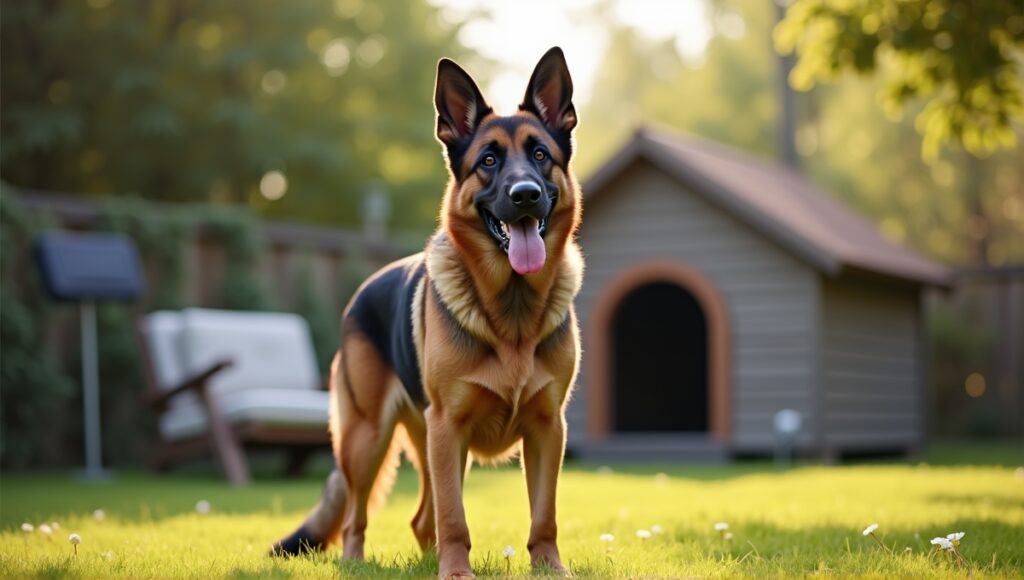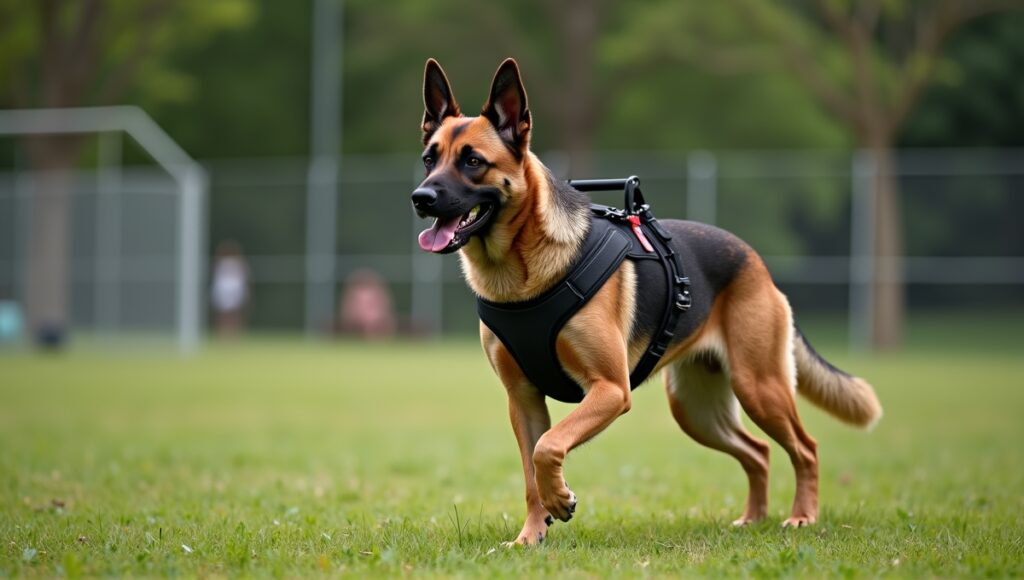Guard dogs are an excellent security measure for your home, yet training a guard dog isn’t comparable to training your family pet to play fetch. It takes dedication, time, and skill. I have years of experience working with guard dogs, and I’ll cover the basics of guard dog training. You’ll learn the best breeds for the job, the core training methods, and key safety tips.
Understanding Guard Dog Training Basics

Guard dog training isn’t about creating an aggressive animal. It’s a process of developing a well-behaved, obedient dog that can protect your property and family. I’ve trained many guard dogs on our farm, and I can tell you it’s all about balance.
The main goal? To teach your dog to be alert and protective without being a threat to innocent people. This is different from attack dog training which focuses on aggression.
What makes a good guard dog?
- Intelligence
- Alertness
- Calm temperament
These traits allow the dog to assess situations and respond appropriately.
Early socialization is crucial. You want your guard dog to be comfortable around people and other animals. This helps them distinguish between normal situations and real threats.
Obedience training forms the foundation. Your dog needs to respond to basic commands like:
- sit
- stay
- come
- leave it
- heel
These commands give you control in various situations.
Remember guard dog training takes time and patience. But with consistent effort, you’ll have a loyal protector who’s also a beloved family member.
Selecting the Right Breed

The breed you choose to train as a guard dog is very important. There are many different breeds that you can train as a guard dog, and each breed has its own unique characteristics.
- German Shepherds are one of the most popular choices because they are intelligent, loyal, and easy to train.
- Rottweilers are extremely powerful and very protective, making them excellent guard dogs.
- Doberman Pinschers are very alert and very brave natural protectors.
When selecting a breed, take into consideration the amount of space you have available. Many of the breeds used for guard dogs are very large, and they need plenty of space to move around.
Some breeds are less active than others. For example,
- Mastiffs are relatively inactive compared to other breeds.
- If you live in an apartment or don’t have a particularly active lifestyle, select a breed that is equally inactive. Otherwise, they’ll become bored and potentially destructive.
Don’t forget about the dog’s temperament when selecting a breed. The dog you’re training as a guard dog should be confident, but it shouldn’t be aggressive. If a dog is overly aggressive or overly fearful, it likely won’t make a very good guard dog, and you’ll find yourself fighting an uphill battle while training it.
Each breed has its own advantages and disadvantages. For example,
- German Shepherds shed a lot.
- Rottweilers can be a bit stubborn.
- Doberman Pinschers are extremely energetic.
In other words, consider the breed’s characteristics and then select a breed that will help you live out your lifestyle. Ensure that you can properly train the breed you choose.
If you’re interested in smaller breeds for your family, you might even want to consider best small family dogs that could also serve as a loyal companion.
Foundational Obedience Training for Guard Dogs
Basic obedience is the foundation of guard dog training, so I always start here before progressing to more advanced skills.
- Start with sit, stay, and come, as these commands allow you to maintain control in different scenarios. Practice these commands in various environments to ensure your dog will listen to you in any location.
- Train your dog to heel, so they won’t pull on the leash during walks. This is essential for controlling your dog in public.
- Use positive reinforcement to train your dog. Give your dog treats, praise, or toys when they do something you like. This will create a strong relationship, and your dog will be more likely to listen to you.
- Be consistent with your training. Work on these commands every day, even if it’s just for a few minutes. Doing so helps your dog understand and remember what you want.
- Integrate commands into your everyday life. For example, have your dog sit before you give them food, or ask them to stay when you’re about to open the door. By doing so, you’ll reinforce the dog’s training in real life scenarios.
- Be patient. Some dogs learn quickly, while others take more time. Regardless, stay positive, and keep the training sessions fun and interesting.
Socialization and Environmental Exposure
Socialization is also important for guard dogs so that they can discern normal situations from actual threats.
- The more people, animals, and general environments your puppy can safely experience, the better. This helps build confidence and eliminate fear-based aggression later on.
- Put your dog in different environments. The more varied, the better. Visiting a park, a store, and a busy city street all provide different learning experiences.
- Let your dog meet different people. As many different types as possible. This includes another strategy of walking your dog through a highly-trafficked area or park.
- Associate meeting new things with something positive. Use treats and praise if your dog is clearly scared or nervous around something new.
- Gradually increase the difficulty of experiences. Start in a more controlled environment and work your way up to more challenging environments. This teaches your dog to adapt to new situations.
- Remember, socialization never ends. Continue introducing your dog to new experiences throughout their life. This will keep your dog social and confident.
Advanced Guard Dog Training Techniques
Next, let’s discuss more advanced guard dog training skills. These skills all build upon the basic obedience and socialization foundation.
- Train territorial awareness: Take your dog on walks around your property to show them the area they need to protect.
- Train your dog to bark: You can first capture natural barking and then add a command like “speak.” Then, reinforce your dog when he or she barks on cue.
- Train controlled aggression: This step is tricky, as you need to show your dog to be intimidating without actually attacking. You’ll definitely want expert guidance for this step.
- Scenario-based training: Set up scenarios with potential threats, such as a “stranger” approaching your car or home.
- Train your dog to stop: This cue helps you control and avoid unnecessary aggression.
- Train alert behavior: Capture and reinforce any alert behavior to sound or activity.
Always remember that safety is key. Make sure you have the proper protective equipment for more complex training and consider hiring a professional.
Equipment and Tools for Training
Having the proper tools makes guard dog training safer and more effective. I’ve tested many different tools over the years, and here are my top recommendations.
- You’ll need a strong collar and leash to maintain control during training sessions. I use a slip collar for most of the training, especially in the beginning. A harness is a good option for larger, stronger dogs.
- A long training lead is an essential tool for guard dog training. It allows your dog more freedom while still ensuring you have control. It’s particularly helpful for recall training.
- A training vest or jacket is another great tool to get your dog into the mindset of working. For more advanced training, you might need specific tools, like bite sleeves and suits to keep you safe during controlled aggression exercises.
- Reward tools are also important. I use a treat pouch and select a toy to ensure I always have rewards on me. Some dogs prefer toys, while others prefer treats.
- A clicker is another great tool if you’re using reward-based training. It allows you to be very precise in marking when the dog does what you want it to do.
- Keep in mind the quality of the tools you use. Cheap tools will break, and you need strong, well-made gear that can withstand intense training sessions.
Professional Guard Dog Training Services
Professional help is another excellent option. I’ve witnessed many dogs transformed by professional training.
Professional trainers have a wealth of knowledge. They understand dog psychology and can solve more advanced problems.
There are many different professional training programs.
- Some offer board and trains, while others do private or group lessons.
When selecting a trainer, look for certifications and experience.
- Ask for references and watch them train.
Professional training is expensive. Costs vary significantly depending on the program and location. However, the cost is worth it if you end up with a trained guard dog you can rely on.
Look at the program’s objective when making your selection.
- Some are designed for personal protection, while others are better for property guarding.
- Select the one that best aligns with your needs.
Keep in mind that even if you hire a professional, you still need to continue training at home. The trainer should provide instructions for ongoing practice and reinforcement.
Legal and Ethical Considerations in Guard Dog Ownership
Owning a guard dog is a significant responsibility. I always emphasize the importance of knowing the legal and ethical considerations.
- Check local laws. Some areas have breed-specific legislation or require guard dog certifications.
- Consider liability. If your guard dog injures someone, you could be held liable. You might want to consider additional insurance.
- Think about the ethical responsibility. Guard dogs need proper training, socialization, and care. They’re not just security devices – they’re living creatures.
- Make sure your guard dog can’t escape your property. Fences and signs can help prevent people from accidentally encountering your dog.
- Train your guard dog to reliably respond to commands. This will help you manage situations and prevent unnecessary aggression.
- Be a good neighbor. If you own a guard dog, tell the neighbors. If they have concerns, don’t wait for them to come to you.
Remember a well-trained guard dog is a net positive for safety and security without creating unnecessary risk for others. It’s your responsibility to ensure that remains the case.
Maintaining and Reinforcing Guard Dog Skills

Training your guard dog is not a one-time event. I’ve found that regular training is the best way to ensure your guard dog is always reliable.
- Schedule weekly training sessions. Review basic commands and work on advanced commands.
- Create training scenarios to ensure they remember their guard dog training without placing them in real danger.
- Balancing guard duties with family time. Your guard dog needs to switch off and relax.
- Deal with any behavior problems immediately. If your guard dog is overly aggressive or fearful, seek professional help.
- Provide daily physical and mental exercise. An overtired dog is less likely to be reactive and anxious.
- Regularly evaluate your guard dog’s performance. As they get older, their abilities may change, so adjust your training and expectations.
- Remember daily reinforcement. Guard dog training skills will go away without practice. Train them consistently, and you’ll have a reliable guard dog for life.
In Closing
Guard dog training is a significant commitment that demands your time and effort. You’ve covered everything from selecting the appropriate breed to advanced training and legal issues. Keep in mind that an excellent guard dog is more than just a protector. It’s also a loyal companion that can accurately identify true threats while still being a loving family member. Keep investing time into your dog’s training, and you’ll have a loyal protector and friend.






